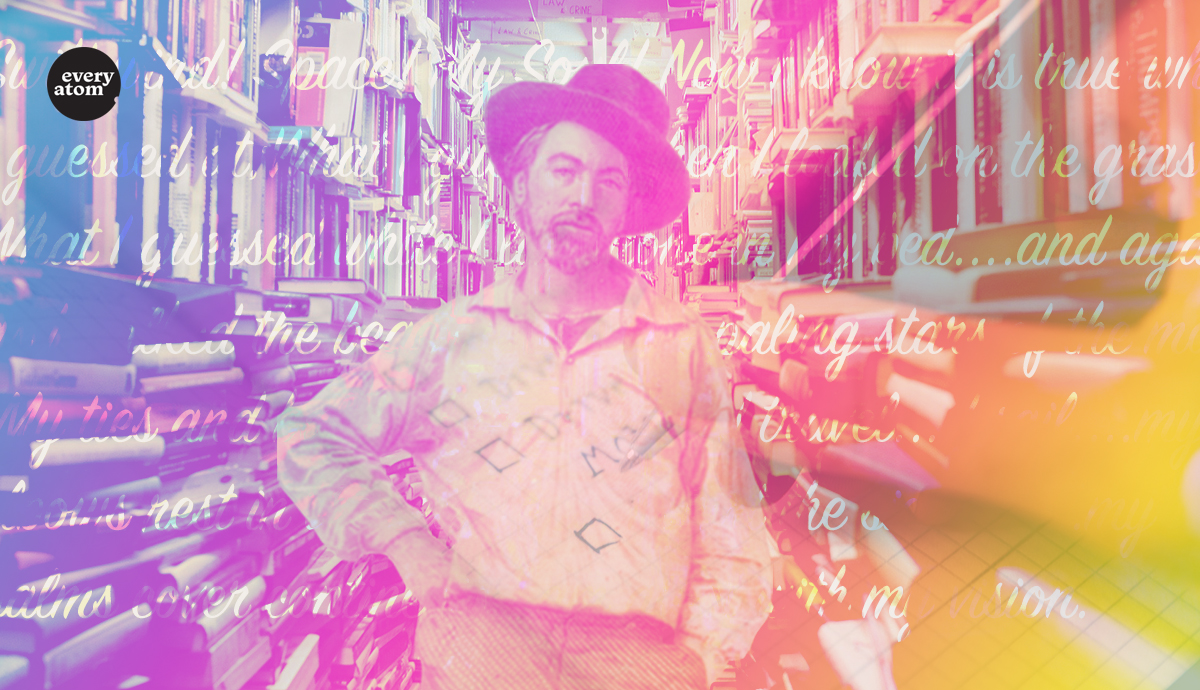Every Atom | No. 178
Introduction to Every Atom by project curator Brian Clements
Whitman lived in a mobile age, and his many poems about what it means to be on the move continue to reach across space and time. Although his world was shaped by different kinds and scales of mobility, his visions of traveling an open road or crossing Brooklyn Ferry, of outriding a beautiful stallion or being a hounded slave speak to our current moment with an intensity that has as much to do with their politics as with their mysticism and sheer beauty. If “Song of Myself” can be read as song of a mobile self in a mobile cosmos, the passage that proclaims “I am afoot with my vision” marks one of its most stunning moments: it captures a sense of being in several places at the same time, of moving yet being perfectly in place, while feeling intimately connected to the entire Earth. These lines are not “about” walking any more than they are about train rides or air travel, and yet they resonate with our own age of global migrations and planetary consciousness.
Whitman’s lines, both realistic and unreal, celebrate a way of being human that is mobile in body and mind, one through and because of the other, and this idea—that walking, sailing, and traveling yield inspiring visions, and vice versa—valorizes all kinds of mobility, including those that have been vilified in Whitman’s time as much as in ours. Journeys at night, flights, migrations: all of these movements, regardless how mundane, enable epiphanies, at least potentially, and all of them become lightweight and joyful, at least for now. This does not belittle the hardships of actual travel and migration, to the contrary. Images of leaving ballasts behind, bridging oceans, and moving through deserts were no more politically innocent in 1855 than they are now, and it seems no coincidence that later in Leaves, Whitman writes, “I am… The emigrant and the exile,” pondering the fate of “the fugitive” and “the immigrant.” His ecstatic lines turn a moment of potential crisis into a spiritual, emancipatory experience, recognizing each and everyone of us who moves in our common humanity, while inspiring those who are locked in place to move in the imagination.
One of the most immediate insights of this passage is that we can be both mobile and in touch with the natural world. The fantastic flight of a poet who lingers among ocean cliffs and caresses continents while racing through space undoes the persistent idea that being on the move precludes a life in tune with the physical earth. Blurring the lines between stasis and mobility, nature and himself, Whitman suggests that both walking the beach and cosmic trips can inspire a sense of being at home on all the lands and waters of the world. In “Song of Myself,” these six lines lead over into a massive catalog, a tour de force during which the poet walks, rides on horseback, and floats in a balloon, taking his readers through landscapes, oceans, valleys, and cities that are brimming with bees and buffaloes, whales and modern crowds. Narrow nativist notions about plants, animals, and people “naturally” belonging to just one place make no sense in such a universe. This does not mean that our human restlessness is environmentally benign; the dynamics that are pushing the Earth towards the brink of ecological collapse include the kinds of wanton mobility that began during Whitman’s time. And yet the grace of his vision suggests that in our common mobility, every atom belonging to us as good belongs to the earth. Or, as Amy Clampitt once put it, “All that we know, that we’re / made of, is motion.”
Recommended
Nor’easter
Post-Op Appointment With My Father
Cedar Valley Youth Poet Laureate | Fall 2024 Workshop







